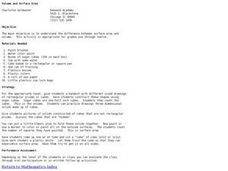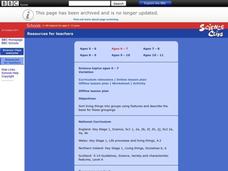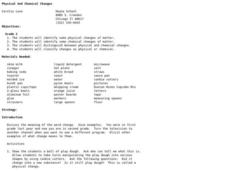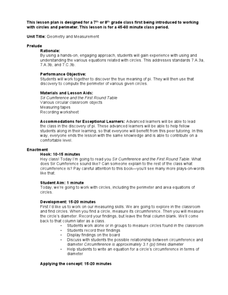North Carolina State University
Shapes
Expose youngsters to 3-D objects in a hands-on learning activity involving marshmallows and toothpicks. Engage your young mathematicians by introducing them to 3-D shapes by means of a story book. Explore 3-D shapes by manipulating...
Curated OER
Classifying Three-Dimensional Shapes
Compare geometric solids based on their properties. Your emergent geometers use spaghetti and marshmallows to build models so they can examine the number of faces, edges, and vertices on polyhedra of their own creation. Resource includes...
Annenberg Foundation
Geometry 3D Shapes: Euler's Theorem
How do you get a theorem named after you? Euler knows what it takes! The third lesson of five asks pupils to use an interactive activity to compare the faces, vertices, and edges of seven different three-dimensional solids. They use...
Curated OER
Solids, Liquids, and Gases
Students explore the three main forms of matter: solid, liquid, and gas. They examine concrete examples of each, using their five senses and "experimenting" to find differences in them. They find pictures of each, cut them out and past...
Curated OER
Solids and Liquids
Students complete activities to study the properties of solids and liquids. In this states of matter lesson, students investigate the melting and freezing of a range of materials in a virtual experiment. Students melt the substances and...
Curated OER
What is Matter?
Students investigate what matter is and how it changes states. In this physical properties lesson, students examine the vocabulary database and identify the characteristics of the three phases of matter. Students perform a...
Curated OER
It Matters
Students use descriptive vocabulary to discuss the attributes of matter. Then, they sort objects or pictures by the type of matter they are comprised of. Finally, students match objects of matter with similar attributes and create a...
PBS
Surface Area and Volume
You and your class will like this lesson on using visual models to relate the volume and surface area of solid shapes. Learners construct three-dimensional forms using nets. They calculate the surface area and volume for each and then...
Curated OER
Permafrost: Permanently Frozen Ground
Young scholars explore permafrost. In this 3 states of matter lesson, students identify characteristics of solids and liquids. Young scholars observe water and soil melting and freezing at various temperatures. Students...
Curated OER
Shapes are Everywhere
Second graders gain an understanding of geometric shapes and spatial reasoning. They learn the attributes of solid shapes in everyday activities. Students compare geometric shapes to everday objects, finding things that serve a purpose...
Curated OER
Crystals
Students investigate patterns in solids, the structures of crystals and rocks made up of minerals. In this crystals lesson plan, students review solids, make patterns with Styrofoam balls, make crystals in the lab and observe their...
Curated OER
Crystal Painting
Students investigate crystalline solids. In this crystals lesson, students observe samples of natural crystals and compare and contrast each. They draw pictures with crayons and then paint over their picture using crystalline solids...
Curated OER
Where has Polly Gone?
Learners explore polygons and their uses in careers. They also discover polygons shapes in manmade objects and nature. They use their acquired knowledge to construct a strong structure using polygon shapes.
Curated OER
Snowflake Bentley
Young scholars explore crystals through the story Snowflake Bentley and then create crystal pictures of their own. In this interdisciplinary lesson, they create a crystal web chart on chart paper, design artificial snowflakes, and write...
Curated OER
Volume and Surface Area, A Sweet Activity
Geometry.... sweet! Using sugar cubes, learners build rectangular prisms of different sizes and shapes. They glue them together and assess volume. Then they color the outer sides to visualize and compute surface area. To make a visceral...
Curated OER
Science- Unit on Matter- Liquids-
Second graders discover that everything is made of matter. they determine the properties of liquids and that like solids, liquids can be grouped or classified according to properties or qualities. they assess that solids have a definite...
Curated OER
States of Matter For Grades Kg-8
Students conduct studies of states of matter. In this science lesson plan, students observe the properties of matter and classify different substances as solids, liquids, and gases.
Curated OER
Glacier Slide
Students conduct an experiment. In this glaciers lesson, students learn about glaciers and then perform an experiment to show how glaciers shape the landscape around them. Students draw a picture in their journals to...
Curated OER
Watching Crystals Grow
Students observe crystal growth of Epsom salts and the variables that hinder or help their nucleation and growth. They illustrate a series of drawings/pictures as the crystals grow. They look for the different shapes they form as well...
Curated OER
Science: Liquid Matter
Second graders examine the properties of liquids and their classifications. They compare and contrast cups of different liquids and record their findings in journals. Students observe how liquids flow at various speeds and that unlike...
Curated OER
Science: Water States
First graders investigate the various forms of water. They discuss the properties of water. They discover examples of water's various states and locate other solids, liquids, and gases in their homes.
Curated OER
Variation
Students practice sorting living things into groups using their characteristics. Using pictures of leaves and animals, they sort them based on their color and shape and write the objects characteristics under the picture. They share...
Curated OER
Physical And Chemical Changes
Second graders identify physical and chemical changes of matter. They distinguish between physical and chemical changes. They classify changes as physical or chemical.
Curated OER
Geometry and Measurement
Students view a right triangle displayed by the teacher. Students measure legs and the interior angles of the triangle. They look for a pattern or relationship between the legs and angles. Students use pegboards and string to create more...























